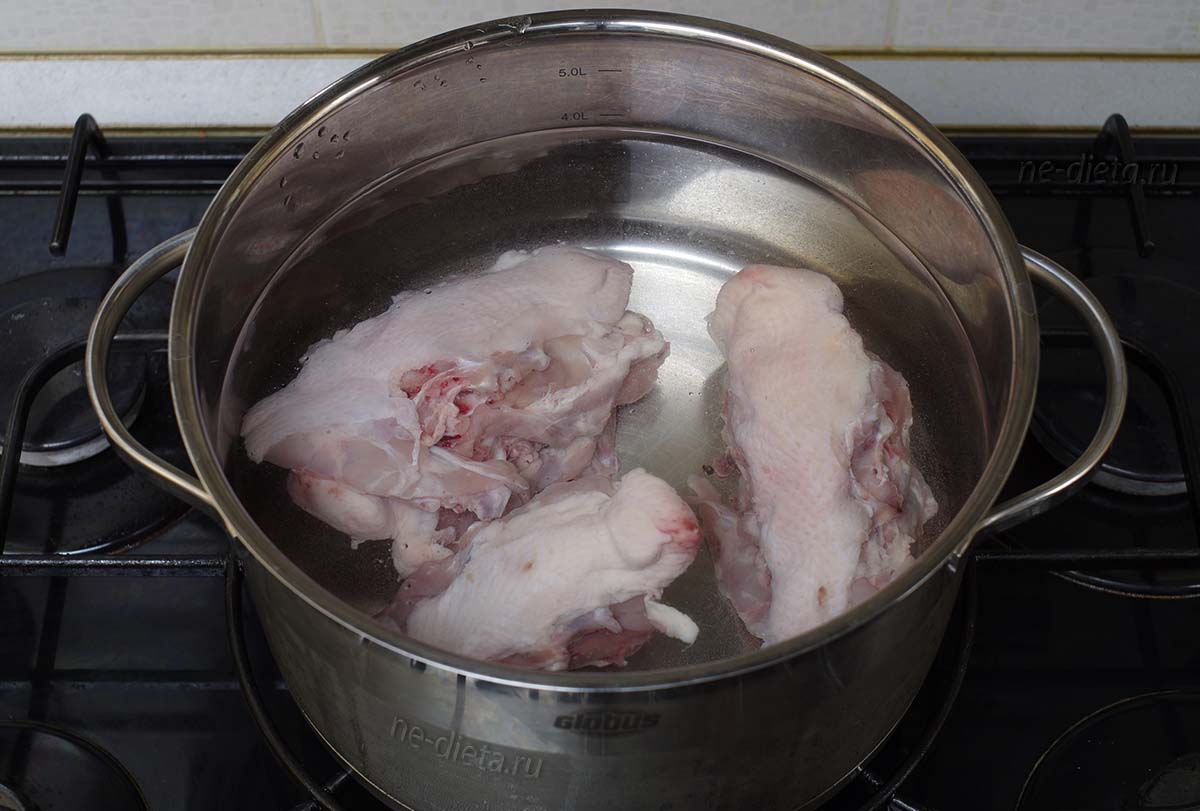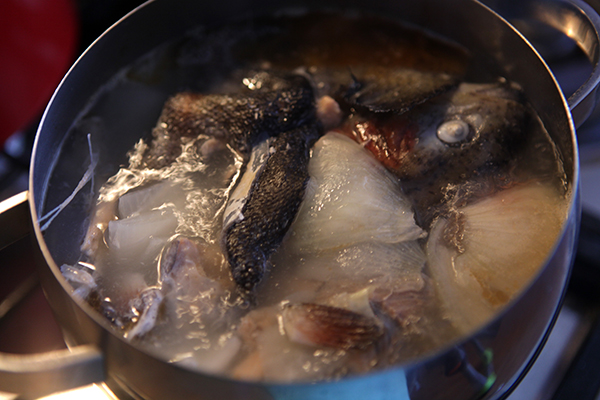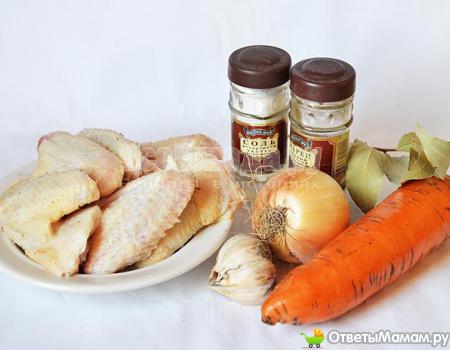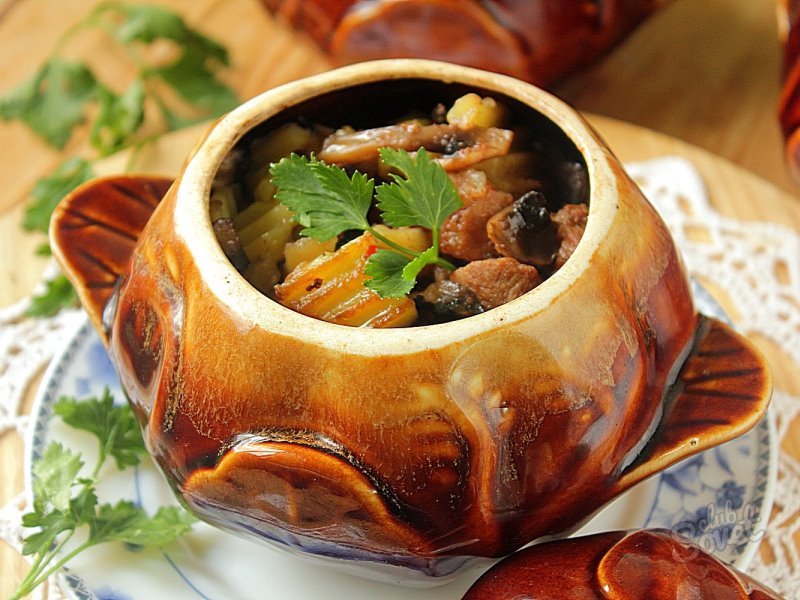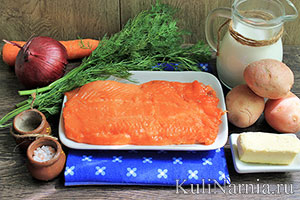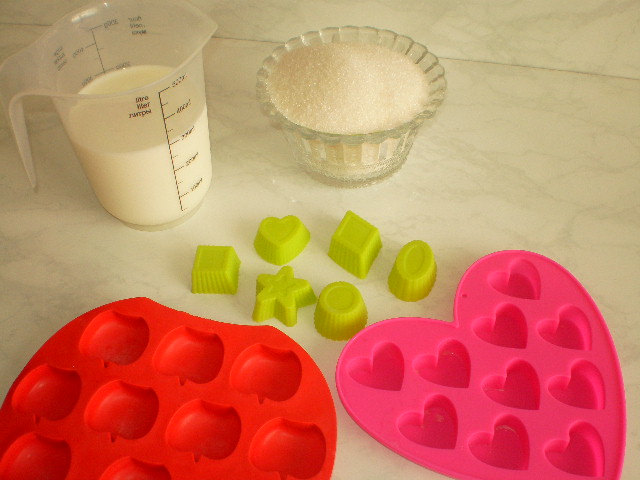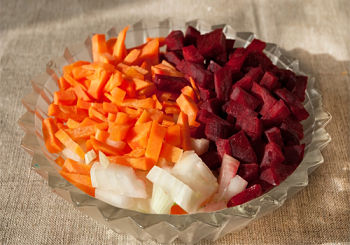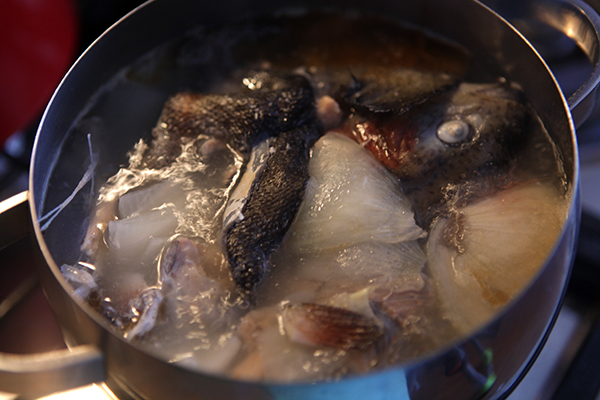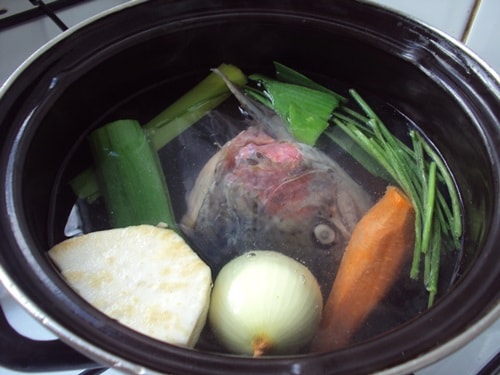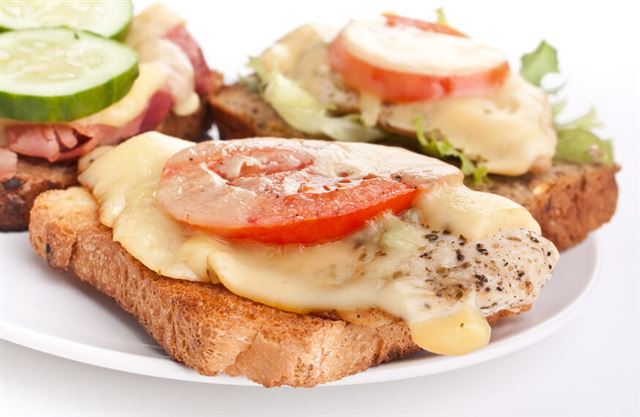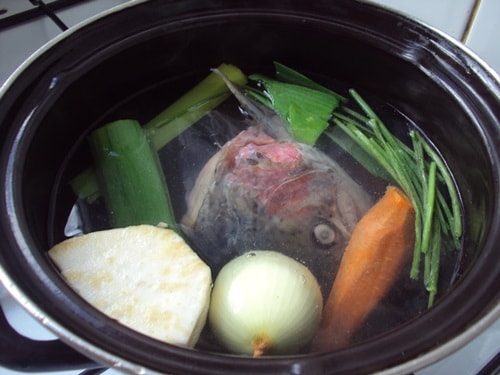Recipe how to cook chicken broth after surgery. How to choose a chicken
After large surgeries on the abdominal organs, they usually refrain from administering food to the patient for 24-36 hours. However, a longer fasting is unacceptable, as it not only depletes the patient, but also supports postoperative acidosis, suppresses gastric and intestinal motility, and predisposes to various complications.
In the postoperative period, the surgeon individually, depending on the nature of the surgical intervention and the patient's condition, determines the necessary diet, meal time and further expansion of the diet. As before the operation, in the postoperative period, great attention is paid to the introduction in sufficient quantities of liquid, salt and carbohydrates, in the following days - proteins and vitamins.
After resection of the stomach, hunger is prescribed for 36-48 hours. When dry mouth is allowed to rinse your mouth or wipe with a wet swab the mouth. The body's need for fluids and salts is satisfied by intravenous administration of saline and 5% glucose solution.
On the 2nd day, the attending physician may allow one glass of sweet tea, which is given in a teaspoon in 15-20 minutes during the day.
On the 3rd day, the patient receives two glasses of liquid (low-fat, weak broth and sweet tea) also in separate sips during the day.
On the 4-5th day, they allow broth or slimy soup, jelly, jelly, sweet tea, fruit or berry juices, diluted with sweet warm water (diet 0).
On the 6-7-8th day, a surgical diet 1 is prescribed, which consists of the following products and dishes: 100 g of whole-day white bread crumbs, liquid semolina porridge or rice or buckwheat porridge cooked in water with the addition of a small quantities of milk and butter, broth or slimy soup, meat steamer soufflé or meat puree, steam omelette, soft-boiled eggs, butter, kefir, jelly, jelly, dogrose infusion, sweet tea, juices from fresh berries and fruits. You need frequent meals every 2 hours, one dish should be no more than 200-250 g per reception.
On the 8th-9th day after the operation, the patient is transferred to a diet of 13. In some medical institutions, this diet is referred to as 1 surgical.
In case of total gastrectomy in the first days after the operation, Spasokukotsky nutrition is carried out: a nutritional mixture of two eggs, 400 g of milk, 50 g of sugar and 25 g of butter are introduced through the trocar into the upper part of the jejunum. On prescription, the patient is fed 2-3 times a day.
After surgery on the biliary tract in the normal course without complications, the patient is fed according to the following scheme:
- 1st day the patient does not receive food through the mouth
- on the 2nd day - sweet tea, jelly, slimy soup without butter; you can write a diet 0
- on the 3-4th-5th day, a surgical diet 1a is prescribed, with the replacement of broth by mucous soup and eggs - protein steam omelette
- from the 6th day the patient is transferred to a diet 5a
- 1st day sick fast
- Day 2 gets a diet 0
- 3-4th-5th day - surgical 1 diet followed by transfer to diet 13, 5a or 4
After gynecological or urological surgery, a surgical diet is prescribed for 2–3 days, then a diet of 13 or 5.
Experience shows that rationally organized can be a significant help in the fight against certain diseases. Take, for example, chicken broth - this dietary, light dish will be very useful during the recovery period after an illness, because it contains valuable substances useful for the body.
Surely we can say that the right chicken broth for the patient will be not only food, but also medicine.
Most often, the diet of patients after serious diseases, including after leaving a coma, begins with this light to the stomach dishes. In the period after a long illness or operation, the body is weak, depleted, it needs recovery.

Chicken broth for the patient after surgery, or other serious illness, will be light and healthy food.
- In after the operating period
- After
- After poisoning
- During colds
The main advantage is the ability to recuperate without additional load on, it is easily digested, increases the appetite. If the diet is very strict, but chicken broth is still possible, then nutritious and tasty, prepared with care, it will bring a lot of benefits to the patient, improve health and mood, which is very important in a hospital.
Hospital food, usually, though useful, but with special taste is no different.
But how to cook chicken broth for the patient, so that it is useful and tasty? With a strict diet, the dish should not contain fat. To do this, the chicken is pre-cleaned from the skin, remove the fat, boil for 15-20 minutes, then the water is drained, a new one is poured, and boiled again over low heat for another 1.5-2 hours.
In the end you can lightly salt it, but the smaller the better. This ends the cooking, it should be cooled slightly and served.
Fortunately, not all patients put such, then the recipe can be varied by adding more ingredients.
Be careful about the fact that in some diseases, chicken broth is contraindicated, consult your doctor before use.
Use of the dish
Calorie - about 30 kcal per 100 grams.
The use of the product has been known since ancient times, and nowadays it has been scientifically confirmed, it contains many useful substances:
- group B
- Amino acids, proteins, carnosine
- Polyunsaturated fatty acids
- Iron, Selenium, Calcium, Copper,
Iron from chicken is well absorbed, therefore, with reduced hemoglobin, decoctions or soups from it should be included in a rational diet. , proteins, amino acids contribute to the speedy recovery, return to good health.
Due to its rich protein content, broth is an excellent means of preventing stroke and hypertension.

However, all this is true only for dishes made from rustic chicken. Factory birds contain unknown substances, which may be antibiotics, chlorine.
If you can not buy a homemade chicken, then give preference to a chilled product of domestic production.
- For greater benefit and rich taste, in the process of cooking in the pot add: onion
- bay leaf
- greenery
- spice
Chicken broth, recipe for the patient
The recipe for the patient may differ, depending on what led the person to the hospital. If the patient can not fat, then cooking is done in two waters and take bone broth or breast for the broth.

- To get a rich taste of chicken cooked for at least one and a half hours
- Begin to cook chicken in cold water
- The weaker it boils, the less foam is formed, and the broth turns out light.
- For rich color and flavor, vegetables and bones are baked in the oven
- At the beginning of cooking add a little salt, then at the end, almost ready dish, salted to taste
- Vegetables cut into large pieces
- Strong-smelling spices interrupt the taste of chicken, as well as vegetables with a pronounced taste (bell pepper, for example)
To prepare the simplest option you need to take the following ingredients:
- 1 kg of chicken bones or pieces with stones
- 1.5 liters of water
- Spice
Put the chicken parts in a saucepan, zalele cold water, lightly salt. Before boiling, remove the foam, reduce the heat, so that the boiling process is not much. Add spices, usually a couple of bay leaves, black pepper-peas.
Boil about one and a half - two hours. If you use more meat than bones when cooking, then you need to cook less - about an hour.
If you want to add vegetables, then it should be done after boiling. Onions, carrots cut into large pieces, garlic cloves are thrown whole. Greens are added at the end.
If the bones of the chicken are pre-baked in the oven for about half an hour, the temperature is 180 degrees, then the broth will turn out to be a rich golden color.
The effectiveness of chicken broth for colds
The healing properties of the product obtained from cooking chicken were noticed a long time ago, in fact, it effectively fights cold symptoms. As mentioned earlier, it contains a special substance - carnosine.
It is a dipeptide, a compound intermediate between polypeptides and amino acids.
It has many positive properties:
- Antioxidant, neutralizes toxins in the body
- Stimulates the system
- Increases Stamina
- Maintains blood flow in the brain
With a cold, the patient is supposed to get plenty of warm drink, fragrant, warm broth can reduce, ease breathing, and the state of health improves.
Medical scientists argue that the effectiveness of expectorant drugs in comparison with abundant drinking has not been proven. This means that for colds, instead of drugs (such as acetylcysteine,), for cough, you can simply drink liquid in large volumes.
The dish, prepared especially for the patient, contains not only useful substances, but also warmth and care. And a person is always pleased that they take care of him in a difficult moment, perhaps this is what helps to quickly cope with a cold.
Now let's see a video from the chef with recommendations for cooking:

To cook chicken broth for the patient, it is enough to choose a high-quality chicken and master the simplest skills of cooking this dish. All chicken broth recipes are quite simple - in this case, you just need to cook the bird correctly.
However, there are some peculiarities of cooking time and the addition of certain components. Chicken broth for the patient should not be too fat - this is the main rule. Especially if it is prepared for those who are after surgery.
A detailed description of how to prepare chicken broth for the recovery of a sick person after a cold, surgery and other complications is given below.
Chicken broth - great food for the patient after surgery
First of all, it is necessary with particular responsibility to approach the choice of the main product, from which the broth - chicken will be obtained. It is good if we probably know its origin (a proven producer or a village chicken, acquired from friends).

But in most cases, the purchase is done in a regular supermarket. Therefore, we need to arm ourselves with what nature has given - with eyes, smell, and tactile sensations.
Here are some simple tips on how to choose the right meat for chicken broth, which will help a person recover from surgery:
- First of all, it is not necessary to buy a bird in unchecked places - from hands, in unfamiliar markets, etc. It is better to purchase it in packaging, with all the corresponding marks (manufacturer, GOST, date of manufacture and packaging, the expiration date).

- We immediately dismiss the option with frozen chicken - in most cases it is better to buy chilled meat. First, then we do not overpay for ice, which adds “extra” grams. And most importantly - frozen meat can neither smell nor touch. Therefore, there is a real risk of facing poor quality products that have long been overdue.

- Of course, first of all we pay attention to the appearance. The surface of the chicken skin should be smooth, free from defects. The skin is clean, elastic. The presence of feathers, dents, scratches is unacceptable.
- To determine the age of the bird, you can simply look at the color of the skin. In young chickens, it is pink, quite pleasant color. Older chickens are yellowish, which is quite normal. Such meat cooks longer, although it makes a very rich, fragrant broth. Cyanotic, blackened, green carcasses categorically exclude.
- Now check the freshness of the meat. One thing - the date indicated on the package, another thing - our feelings. Just push on the skin surface (fleshy parts). Fresh meat instantly "springs", no dents will remain. The old will leave a "hole".
- In addition, the old chicken will have a rather loose skin - on the surface it will give several folds, and the color will be very heterogeneous.

- And the last moment. Even if the chicken looks all right, be sure to smell it. If the smell is fresh, then the eyes are not deceived. The slightest odors - a reason to reject the carcass.
How to cook chicken broth for a patient after surgery: a classic recipe
This dish is very simple, although it is cooked for a long time:
- Average cooking time of at least 1.5-2 hours.
- At the same time the caloric content is only 15 kcal per 100 ml of liquid (essentially 2 g of protein per 100 ml of soup). Moreover, every 100 grams of the meat itself will give about the same calories - about 120-140 kcal, which is quite normal.
In the classic recipe, we need these products:
Ingredients
- chicken - 1 bird;
- water - 3 liters;
- onions and carrots - 1 each;
- greens - 1 sprig (usually dill);
- chicken eggs - 2-3 pieces (or 4-5 quail);
- salt - to taste.
We will act this way - first of all, we will determine the part of the carcass from which we will cook chicken broth for the patient:
- if a person just needs to recuperate after a debilitating illness, a cold, or after surgery, you can use any part.
- but if a strict diet is prescribed (for example, in case of diseases of the digestive organs), our option is only the breast and the maximum of the wing.
- at the same time it is better to remove the skin from the chicken to the maximum.
How to cook chicken broth - recipe
Step 1. Cut the skinless chicken into 3-4 large pieces (or divide the carcass into 2 halves) and place in cold water. You can put it entirely - then it will be easier to get, and cooking will take a little longer. This is not a fundamental moment.
But the amount of water matters - it needs to be taken 3-3.5 times more than the chicken. For example, a chicken carcass weighs 1.5 kg. Then we take a large saucepan and pour 5 liters of water into it at once, because some part will inevitably boil away.

Step 2. Put the pan with the chicken on the fire and first turn on the stove at full capacity. You need to wait for the boil, and then immediately reduce the heat to medium. This is a very important stage, because it depends on him how to cook broth from chicken for a sick person, and for healthy people.
All the while watching the foam and remove it. And also - boil it in a saucepan without a lid, because otherwise the water will become too turbid due to strong boiling.

Step 3. Immediately after boiling the soup can be salted - first, it is better to take a deliberately small amount of salt, for example, a teaspoon. Because of this, we definitely do not pereolim our broth. To make the broth taste good, you can also add bay leaf and a couple of sweet black peppercorns.

Step 4. After boiling, the broth will boil for at least 45 minutes, and in the case of the old chicken - from 1.5 hours. All this time he should not boil at all.
On the surface of the water should be very weak, barely noticeable formation of bubbles (water temperature not more than +80 o C). And again, we constantly remove the foam, especially since after adding salt it will for some time depart more intensively.

Step 5. Meanwhile, carefully wash the onions and carrots, remove all contaminated places. Cut vegetables in half and fry in a completely dry frying pan until a blackish surface appears.
As a result, the vegetables should get something like this. It doesn’t look very appetizing, but it’s not scary - they are not meant to be consumed, but to create the taste and color of our broth.

If there is no time or opportunity to mess around with roasting, then you can do so. Peel carrots, rinse, cut into large cubes. Peel the bulb and also wash it. You can also take parsley root - cleaned and well washed.
Step 6. Put vegetables into broth and cook all together for 15-20 minutes. We taste the broth, add some salt if necessary.

Step 7. Turn off the fire, cover the pan with a lid and leave on the stove (if necessary, cover with a thick towel). The soup must be brewed for another half an hour, or even more.

Step 8. Meanwhile, cook 2-3 chicken or 4-5 quail eggs. This can be done according to your desire, because eggs serve only as an addition to our main recipe. But eggs will give additional calories without the slightest fat, and more - they will give beauty to the finished broth.
Step 9. Everything is almost ready. Now we take the meat out of the pan, remove the vegetables - they have already given their color and flavor. Be sure to filter the chicken broth through a sieve. This is a general principle of cooking chicken broth according to the classic recipe - both for the patient after surgery and in other cases.

Add some greens and half a boiled egg when serving. If you want to make the dish more bright and beautiful - add also some slices of carrots to the plate.
And do not forget to sprinkle with finely chopped dill. If necessary, the broth can be salted.
 Chicken broth for the patient - with herbs and eggs
Chicken broth for the patient - with herbs and eggs As a result of uncomplicated efforts, we get a tasty dish - chicken broth, which has long since become classic. It awakens the appetite and evokes some cozy, homely sensations. And most importantly, it helps a person recover from surgery or illness, gives him new strength for life.
Bon appetit and bless you!
Chicken broth is familiar to its taste from childhood, when, during a period of colds, it was given to replenish its strength and speedy recovery. Even without vegetables and pieces of meat, the broth is very nutritious and satisfying, and if it is flavored with spices, it is very tasty.
How to cook chicken broth to make it tasty? And what is its use?
Chicken selection
Delicious chicken broth is obtained from homemade chicken. But, boil such a carcass, not everyone can afford. Therefore you have to buy.
Of course, it is possible to boil the whole purchased chicken, but it is better to give preference to the sliced carcass. On sale there are already prepared bouillon sets, which include wings and chicken carcass with a small amount of meat. These kits are very good as a base for light vegetable or mushroom soups.
For noodles or noodles, choose chicken parts with meat and stones, such as ham or shin. So the broth will turn out to be satisfying.
As for chicken breast, it is better not to use it for cooking broth. It does not give the fat, which is necessary for broth. It can be cooked separately and add to the already prepared broth.
From the chicken back is obtained the fattest broth. After cooking, it can be drained or diluted with water, or boiled back with fillets - this can reduce the fat content of the future broth.
If it is necessary to cook a chicken consommé for a child, it is better to make it from the hips, legs or breast of the bird. So, the tasty chicken broth will turn out not fat, but also very useful.

How to cook traditional chicken broth?
How to cook chicken broth so that it is not only tasty, but also brings only benefit? For this you need to follow a few rules of proper cooking.
In the classic version of the consomme from poultry several ingredients are used:
- poultry or chicken bones - 1 kg;
- carrot - 1 kg;
- bulb onion - 1 head;
- salt - to taste.
Before cooking, all products are washed and cleaned. After that, the washed chicken or its parts are placed in a pan and poured with water so that it covers the meat. The pot is put on a strong fire and waiting for boiling. As soon as this happens, reduce the heat to minimum and leave to cook.
The foam that appears during the cooking process must be removed. While chicken meat reaches readiness, start cutting vegetables. In this matter, there are no clear settings: onions and carrots can be cut into small pieces, halved, into 4 parts, or left entirely. It all depends on whether they want to eat vegetables in the broth or simply want them to add their flavor.
So, vegetables lay in broth. Foam continue to shoot. Continue to cook until the meat is ready, as a rule, it takes 30-40 minutes. But, if chicken bones are boiled, then the time is extended for another hour or two.
The readiness of poultry meat is determined by piercing the meat fibers on the legs. If this is done easily, then the bird is ready. Remove it from the pan should be quickly, so that she did not have time to dry, and cover with a cloth or gauze.
Vegetables, if cooked whole, are also removed from the pan, and the chicken broth itself is filtered. You can add chopped greens to the ready, clean broth. Overdoing with seasoning is not necessary, it can spoil the true taste of consommous poultry. The best seasoning is salt and vegetables, which are cooked with chicken.
Disease use of broth

The benefits of chicken broth in the disease is not proven by one generation of people. Although, there is such an opinion that this liquid dish is not advisable to give people with colds, since it is hard to digest in the stomach, which leads to a deterioration of the condition.
But, if the broth is cooked correctly, from lean parts of poultry, and also filtered at the end, then it is the opposite - it will be useful. After all, it has a huge amount of substances that are so necessary for recuperation.
Also, chicken broth normalizes the work of the heart system, the gastrointestinal tract. It is useful for gastritis and those who are assigned a diet.
They treat broth from poultry meat not only serious diseases, but also a hangover. Freshly boiled liquid helps get rid of alcohol poisoning, replenish strength, relieve nausea and dizziness.
Could there be harm?
Chicken fat can also harm the body. It depends on several factors:
- Selected stale chicken carcass or its components.
- Onions and carrots are fried before going to the pan. Fatty food, as you know, does not benefit, only saturation.
- Drink broth need to measure. No matter how tasty it turned out, they should not be abused. The stomach will not have time to cope with the fatty food entering it.
Obviously, the broth itself is not harmful. Harmful qualities manifest from human inattention.
Which broth is considered the most useful?
The broth made from poultry is considered useful. But, this does not mean that the purchased chicken will not benefit at all. Domestic chickens do not contain any substances of a chemical nature.
However, what's good in broth?
- High content of protein, which is the main building material for muscle fibers. This component is easily absorbed by the body and is contraindicated only for those with protein intolerance.
- Vitamins of group B, which have an effect on the metabolic processes of the body, immune, nervous systems. Improves the condition of the skin, nails and hair.
In addition, chicken broth - low-calorie food. 100 grams of infusion contains only 50 kcal. The energy value of 100 grams is as follows:
- proteins: 4.3 g;
- fat: 3.6 g;
- carbohydrates: 0.4 g
About how many calories in chicken broth, and nutritionists say, who designate this dish as the main one. Therefore, if there is a need for weight loss, then a decoction of chicken meat is the perfect first course.
Broth with egg
Such a dish is in itself nourishing and healthy, but if you add an egg to it, it will not spoil it at all. How to cook chicken broth with egg?
- bird tibia - 3 pcs .;
- water - 3 liters;
- chicken egg - 2 pcs .;
- onion head - 1 pc .;
- orange root vegetable - 1 pc .;
- salt - half a teaspoon;
- peppercorns - 5 pcs .;
- bay leaf - 3 pcs .;
- sunflower oil - 2 tsp;
- white bread;
- green onion feathers.
And now the cooking process:
- Cooking chicken broth with an egg begins with the fact that they wash their legs, put them in a saucepan, and pour in water. To the same place, they put peppercorns, bay leaves, washed onion in husks and carrot, cut into cubes. Such a set is sent to medium heat. Spot 1 hour.
- As soon as the broth boils, it is necessary to remove the foam from it. After half an hour boiling add salt to taste.
- While the broth is boiled, boiled eggs are boiled.
- Boiled eggs are cooled.
- Vegetable oil is poured on a heated pan and pieces of white bread are fried to golden brown.
- When the broth is cooked, remove the onion and carrot from it. Eggs are cut in two.
- Serve the finished dish in a deep plate with chicken leg, half an egg, sprinkled with croutons and finely chopped green onions.
This is an excellent low-fat food with high protein content. But at dinner it should not be consumed.

Chicken broth in a slow cooker
Anything can be cooked at the slow cooker. And chicken broth in a slow cooker is no exception. Preparing a dish in this device is simple, and, most importantly, with time saving.

Who has a slow cooker, write down the recipe. It will take:
- chicken soup set - 0.5 kg;
- carrot - 1 small;
- water - 2 liters;
- onion - 1 pc .;
- black pepper, salt - to taste.
Step-by-step recipe:
- The pieces from the soup set are washed under running water, the fat and skin are removed.
- Carrots and onions cleaned, washed.
- Multicookers put chicken parts in a bowl, pour water, salt, pepper, place whole vegetables.
- On the device, set the mode "Soup", which lasts 120 minutes.
- Ready broth should be filtered and served on the table, pre-sprinkled with herbs.
Chicken broth in a slow cooker can be cooked in the "Quenching" mode.
For losing weight
Light chicken broth - this is exactly what is needed for losing weight people, as well as for those who prefer proper nutrition.
You will need a familiar set of products:
- young chicken carcass - 1 pc .;
- onion - 1 pc .;
- orange root vegetable - 1 pc .;
- parsley - a pair of twigs;
- celery - 1 stalk.
Now go to cooking:
- The chicken is thoroughly washed and placed in a saucepan. Flooded with water and put on a strong fire.
- As soon as a foam appears on the surface of the water, it should be removed with a skimmer. When the future broth boils, the fire is reduced. Cook on low heat for an hour.
- Necessary vegetables are cleaned, washed, and 30 minutes before the end of cooking is placed in a saucepan.
- A sprig of celery is cut into ringlets and sent to the "common pot" 15 minutes before the cooking process is completed.
- As soon as the broth is cooked, chicken, onion and carrot and celery are extracted from it. Strain the liquid.
- The already extracted circles of celery and chopped sprigs of parsley are added to the already clean chicken broth.
Flavored dish is served hot. After cooling, the taste will not be so saturated.

Add the dumplings
Chicken broth with dumplings - a dish that was prepared by our grandmothers. This is a hearty and incredibly tasty dish that will be an excellent dinner for the whole family.
Cooking is just as easy as regular broth, and dumplings are added just minutes before being cooked.
For their preparation it is necessary:
- egg - 1 pc .;
- flour - 3 tbsp. l .;
- salt;
- dill - a few twigs;
- vegetable oil - 2 tsp.
In a bowl, beat an egg. Dill finely-finely chopped and added to the egg - mix. Pour the flour, pour in the oil, salt and mix. From the saucepan with the cooking broth take a couple of spoons and add to the dough. Stir thoroughly. The dough should not turn out liquid, but not thick.
15 minutes before the broth is ready, spread the dough into it, using a teaspoon. So do dumplings. They will “inform” about their readiness by floating to the surface.
You get a simple version of chicken soup with dumplings, if you add onion and carrot zazharku to the broth.

Broth soup
Simple chicken broth soup is prepared as follows:
- chicken drumsticks - 3 pcs .;
- water - 3 liters;
- carrots - 1 pc .;
- bow - 1 head;
- potatoes - 3 pcs .;
- vermicelli - 2 tbsp. l .;
- salt, pepper, laurel.
Cooking should be this way:
- Chicken drumsticks, after rinsing, pour water and boil over high heat. I remove the foam, and after boiling they reduce the heat to medium.
- Potatoes are cut into cubes and sent to the pan half an hour before the broth is ready. Behind the potatoes send a bay leaf.
- Prepare the onion-carrot fry in oil.
- 10 minutes before the end of cooking, they put vermicelli, fry, salt and pepper into the pan.
- When the soup is cooked, the legs can be left intact or removed from the soup, to separate the meat from the bones, throw away the meat, and place the meat back in the pan.
The soup is ready to eat.
Conclusion
Chicken broth is not only a soup base, but also an independent, healthy dish. It is useful for both adults and children. Not only the composition, but also how many calories in chicken broth speaks about its benefits.
Modern medicine is improving and the disease, previously considered incurable, successfully cured. In order to avoid the subsequent development of the disease or to eliminate the flaws, doctors resort to operations.
The body is experiencing stress, but with their quality and proper postoperative care, the body returns to normal. Therefore, it is important to know what can be eaten after the operation.
what can eat after surgery, are obliged to recommend doctors. General rules of postoperative food:
- 3-4 meals a day, at the request of making snacks;
- give preference to small portions;
- reduce the intake of salt, sugar and fat;
- avoid sugary carbonated drinks and alcohol.
After the procedure, you need to adhere to the gradual introduction of products. At first it will be a little water, then light soups and broths, steamed porridges, low-fat dairy products, low-fat varieties of fish, vegetable and fruit purees. Cooking is better for a couple. Allowed to use whole grain bread or crackers.
The body must recover as quickly as possible and for this you need good nutrition, including vitamins, minerals, proteins, carbohydrates. To do this, diversify the food with cereals, fish, fresh vegetables and fruits, dairy supplies, meat. It is not recommended to use such vegetables as cabbage and radish.
To You can take special supplements to restore the disturbed balance of useful substances.
What you can eat after surgery for appendicitis: the menu for the first days
After excision of appendicitis, the food intake system becomes one of the recovery points for the patient. On the initial day after the manipulation, it is not even allowed to drink. The next day, allowed to drink non-carbonated mineral water.
After 1-1.5 days, it is allowed to take weak Navara and soups, which are desirable to be cooked in water or vegetable broth. For the second one, you can make porridge made from unground, rice or oatmeal. From the liquid is allowed to drink a decoction of the hips and fruit jelly.
Do not recommend to use soup, pea or fish soup, okroshka. As for meat, baking, fast food, carbonated drink, fatty dairy products, then you can forget about them for two weeks. Allowed a little rabbit, which is considered dietary meat. It is permissible to eat low-fat dairy assortment and be sure to have berries, vegetables and fruits.
From Some taste preferences should be abandoned for a while, and you should also listen to these tips:
- chew food thoroughly;
- on the 2nd and 3rd day, resort to small portions;
- eat better 5-6 p. in a day;
- it is necessary to give preference to liquid foods and avoid solid foods;
- food at room temperature;
- choosing the method of food processing, the advantage to give the steaming;
- after the operation, you can eat soup with frayed vegetables, which contributes to the adjustment of the normal digestive process.
Diet (nutrition) after surgery to remove the gallbladder
After the elimination of the organ responsible for the processing of bile, the eating schedule is vital and significantly changes the diet of the convalescent.
What you can eat after gallbladder surgery
- products must be cooked in a steam manner;
- apply fractional food, better less, but more often;
- eat in the same time period.
The strongest diet following the cholicistectomy is prescribed in the postoperative 12 o'clock. In the first hours it is advisable only to soak your lips with water, and later rinse your mouth with unsweetened herbal infusions. The next day, you can drink fruit compotes, low-fat biokefir and lightly brewed tea. Sip water in small doses after a certain time, not more than 1.5 liters per day.
On the third day, reception of crushed potatoes, juice from pumpkin, apples or beets, light rich soup with the addition of 1 tsp is provided. sour cream or plums. oils, cooked fish low-fat varieties. You can drink sweet tea.
On the 4th and 5th day, white loaves, crackers and plain cookies are added in small amounts to the portionion.
On the 6th day, buckwheat, wheat thin porridge or oatmeal is allowed, cooked in a ratio of 1: 1 with milk or water, low-fat meats and low-fat sour-milk provisions.
After a week and up to 1.5 months, you must follow a gentle diet. After this time, it is allowed to follow a general diet. It consists of vegetable and fruit salads with the addition of vegetable fats or sour cream, chicken meat, rabbit meat, low-fat veal, cereal, milk, one egg in 5 days, lean first meals.
The dessert may consist of jam, marmalades, honey or marshmallow.
It is forbidden to use:
- spicy, fatty foods, smoked meats;
- mucus-stimulating supplies (onions, garlic, spices, pickles);
- fatty meat or poultry;
- soda, alcohol and sweets;
- foods with a huge amount of fiber (coarsely ground bread, legumes);
- cold or hot provisions.
Following a balanced diet after getting rid of the gallbladder, it is possible to return to normal lifestyle with a few restrictions on food.
What you can eat after removing stones from the gallbladder
Subsequently, the cleansing of the bile duct from the stones restored the outflow of bile.
AT postoperative period of time should be kept from the use of anti-bile products:
- preservation and pickles;
- food of sharp and fat quality;
- semi-finished products, sausages;
- fish and meat fatty delicacies;
- muffins, sweets and fresh pastries.
On the day following the medical intervention, it is only allowed to hold the liquid in the mouth or wet the lips with a napkin. After their expiration, you can drink sips of hips or mineral water, from which gas is released in advance.
After 12 hours of the operation, it is necessary to drink unsweetened infusion of dried fruit or low-fat kefir, keeping to the interval of 3 hours and in the amount of 100 ml. Take juices and vegetarian soups from 1 tsp. sour cream is recommended for 3 days.
Sticking with sparing diets can eat:
- omelets;
- sandwiches with cheese and a thin layer of butter;
- vinaigrettes;
- the porridges divorced on milk or water;
- meatballs;
- liquid vegetable or fruit dishes;
- light lean soups;
- suitable for drinking nonfat milk, herbal infusions, warm tea;
- for dessert - cottage cheese pudding.
To facilitate the work of the gastrointestinal tract, it is good to stick to a fractional diet.
To resort to edible provisions in a warm condition and cook using the steam method or cook. It is necessary to organize the required intake of fluid in the body. From the bakery range should choose products with bran.
In the first month after the operation, you can eat cereal soups with well-grated vegetables, which prevents irritation of the walls of internal organs. After 2-3 months, you can carefully expand your menu.
Nutrition after intestinal surgery: allowed and prohibited foods
There are many reasons for which there are many operations on the intestines, but before all operated patients there is a problem that you can eat after the operation.
The postoperative diet is divided into three periods:

- Lasts 2-3 days after the surgical treatment and consists in taking warm unsalted foods of jelly or liquid consistency, not more than 250 g at a time. Reception frequency - 7-8 r. per day. In the first 12 hours it is forbidden to even drink water. After this time, pureed vegetable first courses and decoctions, fruit drinks without sugar are allowed. The amount of fluid needed in 1 day - 2 liters. On the following day, it is allowed to eat lean lean broth and fruit jelly. On the third day, you can take liquid porridge, soufflé of fish or meat, one egg.
- The period lasts 7-9 daysand with good health begins a moderate load of the intestines with solid food. Allowed the use of wheat, oatmeal, rice or semolina porridge on the water, meat broth, lean milk.
- Following the dischargefood regime should adhere to at least 3 weeks. Preference should be given to steamed products and low-fat first courses. It is necessary to carefully eat vegetables and fruits to avoid excessive gas formation. After 2 weeks, you can add to the diet any dairy products. Food must be at room temperature.
There is a list of food, from which it is necessary to refrain for a long period:
- sweet and fresh bakery products, chocolate;
- alcohol;
- fatty provisions;
- smoked meat, spices and salt;
- raw milk, fatty milk supplies;
- pasta and legumes;
- raw vegetables;
- nuts and mushrooms;
- cocoa, coffee, soda and cold drinks.
Diet after intestinal surgery (oncology): weekly menu
In the first week after the operational impact, the patient can be fed with broths, vegetable purees and liquid concentration porridges, juices and herbal infusions.
Valid menu for 7 postoperative days:
| Day of the week | Nutrition |
| Monday | Breakfast: dried fruit juice with cracker biscuits |
| Late breakfast: steamed rice with raisins and dried apricots, berry or apricot fresh | |
| Lunch: liquid vegetable soup, assorted cabbage, potatoes and asparagus, tea or herbal infusion | |
| Tea time: baked apples, tea with cakes | |
| Supper: low-fat biokefir | |
| Tuesday | Breakfast: orange juice, pear or peach |
| Late breakfast: peach juice, simple salad, steamed oatmeal | |
| Lunch: pureed lentil soup, steamed chicken cutlets, boiled beets | |
| Lunch: barley porridge, carrot-beetroot cocktail | |
| Dinner: green tea, prunes, dried apricots. | |
| Wednesday | Breakfast: oatmeal poured with milk or kefir, warm tea with oatmeal pastries. |
| Late breakfast: Carrot and celery salad, low-fat boiled fish | |
| Dinner: braised sweet pepper with carrots, boiled poultry meat, cabbage salad | |
| Lunch: rice milk porridge, low-fat yogurt | |
| Dinner: oat bread with yogurt and berries. | |
| Thursday | Breakfast: juice from carrots and some nuts |
| Late breakfast: boiled buckwheat, fruit, lightly brewed tea | |
| Lunch: lean soup, baked eggplant, fruit juice | |
| Snack: whole grain bread, some rabbit meat | |
| Dinner: ryazhenka with Maria cookies | |
| Friday | Breakfast: juice from apples, carrots and beets |
| Late breakfast: zucchini or bell pepper stuffed with rice, unsweetened tea | |
| Lunch: pickle, steamed meatballs, apple-plum compote | |
| Snack: steamed rice with raisins, green tea | |
| Dinner: 250 g of yogurt | |
| Saturday | Breakfast: herbal infusion, a piece of diet bread |
| Brunch: vegetables, orange or carrot-cucumber juice | |
| Lunch: pureed soup, cabbage and carrot salad, wheat cereal | |
| Snack: zucchini stewed with peppers, tea | |
| Dinner: kefir, baked apples | |
| Sunday | Breakfast: low-fat yogurt |
| Late breakfast: cabbage salad, a slice of black bread, fruit juice | |
| Lunch: bean soup, beet juice | |
| Lunch: buckwheat, boiled rabbit meat, weak tea | |
| Dinner: Yogurt with Oatmeal Cookies |
Diet after surgery to remove hemorrhoids: the menu for the week
AT The first postoperative 24 hours. The patient is given only water.On the second day, they begin to feed in small and fractional portions.
For solving the problem: what can be eaten after the operation; several examples are recommended:
| Menu option | Nutrition |
| 1 option | Breakfast: oat bran poured with boiled water with raisins and dried apricots, tea |
| 2nd breakfast: croutons, cherry juice | |
| Lunch: ground cabbage soup | |
| Lunch: a portion of yogurt or low-fat cottage cheese | |
| Dinner: steam cooked meatballs | |
| Option 2 | Breakfast: boiled egg, weakly brewed tea |
| 2nd breakfast: two apples, better baked | |
| Lunch: potato and cereal soup, boiled poultry meat, fruit cocktail | |
| Snack: crackers, decoction of the hips | |
| Dinner: semi-liquid cottage cheese, tea | |
| 3 option | Breakfast: semolina, green tea |
| 2nd breakfast: berry souffle | |
| Lunch: light lean cream soup, boiled lean meat, fruit juice | |
| Snack: steam omelet, baked apple, orange juice | |
| Dinner: boiled low-fat fish, tea |
This menu is maintained for 7 days after surgery. For a month after the intervention, eating foods that promote flatulence, as well as vegetables that can irritate the intestines (onions, garlic), is prohibited.
From the diet it is necessary to remove foods that cause blood flow to the pelvis. It's all spicy, smoked, marinated. Need to give up alcohol.
Nutrition after gynecological surgery
Compliance with the feeding regime after gynecological abdominal surgery is of great importance in the resumption of the female body. In the first 24 hours, intravenous injections, having an anti-inflammatory effect, are introduced as needed and no food is allowed. After this period, you can enter into the diet of infant formula.

A little later, it is allowed to eat cereal liquid porridge-mashed potatoes, containing fiber. During this period, it is forbidden to take bread, full-fat milk and soda. The menu is worth diversifying light food and avoid taking raw foods.
A week later, the diet should be significantly increased by adding leafy greens, low-fat meat and fish treats, steamed.
It is desirable to drink a decoction of wild rose and dried fruit. Cranberries and prunes have anti-inflammatory properties, their use is advised during this period.
What you can eat after surgery gastric ulcers
The scheme of the postoperative nutrition system is constructed in the image of therapeutic diets for gastrointestinal diseases, only it is somewhat stricter.
AT the first few postoperative days, it is recommended to refrain from taking drinks and any food. You can drink only water from a spoon. Gradually, liquid foods, mostly broths, are added to the diet. Sour cream is allowed in small quantities.
On the third day, 0.5 l can be taken. liquid food, on the fourth to 1 l. Five days later, it is allowed to eat cottage cheese, semolina and semi-liquid soups. After a week, you can dilute the ration with boiled lean meat and gradually return to the basic ration, which consists of boiled and steamed dishes of a thin soft consistency.
Large pieces need to be ground. Acceptable food temperature is not cold and not hot. It is allowed to have steam omelets, boiled eggs, cod. For drinking fit a decoction of wild rose and jelly. In the first few months, lightly dried bread should be taken.
All smoked, fat, spicy, pickled is contraindicated. Fruits are preferable to cook in compote, and vegetables to choose without the content of coarse fibers.
Special diets for people with no colostomy.The menu must be selected individually and the best solution after surgical manipulation will be a return to the normal mode of eating, provided that the digestive organs are systematically emptied. It is advisable to avoid constipation.

It is necessary to eat regularly, carefully choosing foods. During the formation of a postoperative cicatrix (1 month), gasification products (rye bread, cabbage varieties, eggs, onions and garlic, grapes, spicy additives) should be taken out of use. WITH special care should be taken to fatty and difficult to digest foods.
For a normal bowel reaction to the newly introduced products, you need to use them gradually. It is necessary to observe moderation in taste preferences, eat frequently, but in mini-portions.
Food after bladder surgery
For the first couple of days after surgery, a highly nourishing material is injected into the patient intravenously. On the second day, moisten lips with a damp cloth. On the third day after the operation, you can eat low-fat meals - chicken broth, frayed curd, unstable cereals, which is permitted after the restoration of peristalsis of the digestive system.
On the fifth day, steam cutlets and other dietetic dishes, boiled cereals and other light foods are allowed to be eaten. Later decade after the procedure, the patient can return to the preoperative food.
Nutrition after inguinal hernia removal
The fact that you can eat after surgery to remove an inguinal hernia, should inform the doctor. This is one of the points of postoperative recovery, which is very important. After the hernia repair, you need to monitor the work of digestion, avoiding diarrhea and constipation and avoiding excessive gas formation.
Should remove from the diet the following products:
- high-fat, spicy and smoked meats;
- legumes;
- members of the mushroom family;
- baked pastries and rye bread;
- soda and alcohol, kvass.
An important component of the diet is a high protein food. Following the removal of stitches, you can gradually return to the usual diet of food under the supervision of a doctor.
What foods can be consumed after heart surgery
After surgical manipulations on the heart, great attention must be paid to feeding.

- meat and fat of high fat content;
- vegetable and cream fats, margarine;
- semi-finished products;
- fatty cheeses;
- fast food;
- salt;
- strongly brewed tea and coffee.
Only intake of olive oil is allowed. For the heart and blood vessels it is useful to take fish oil containing omega-acids. It is recommended to eat boiled red meat and poultry. Diet should be varied with vegetables, berries and fruits, nuts, prunes, leafy greens, seafood.
As for dairy products, it can be consumed in small quantities and only low-fat. Drinks are allowed to drink fresh juices, herbal infusions, rosehip infusion, dried fruit infusions, plain and mineral water. Need to abandon baking.
- the proportion of saturated fat in the daily rate of calories should be no more than 7%;
- the share of transgenic fats - no more than 1%;
- normal cholesterol - less than 300 grams per day;
- the menu should contain foods high in fiber and natural fibers;
- it is necessary to burn extra calories while playing sports;
- do not get involved in a high protein diet.
Products for wound healing after surgery
For the speedy healing of wounds, the body needs products containing:
- high protein content (meat, fish, poultry dishes);
- vitamin A (fruits and vegetables of orange color, liver, eggs, leafy vegetables of dark green color);
- vitamin C (citrus, cabbage, bell pepper, tomatoes, green beans, leafy greens);
- zinc (meat and beef liver, seafood, legumes, greens);
- arachidonic acid (lard and liver);
- fatty acids (oil and fish oil).
It is necessary to create comfortable conditions for the patient, comfort, gentle circulation and these complex measures will contribute to the speedy recovery of the body.
What you can eat after heart surgery, and what you can not:
Elena Malysheva tell the audience what you can eat after the operation:



